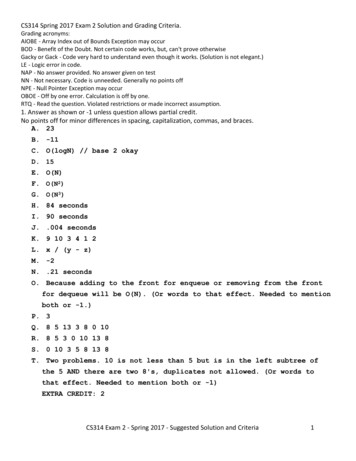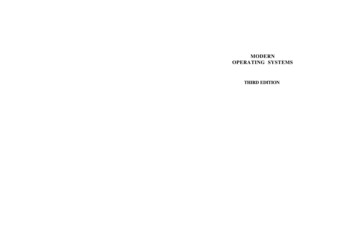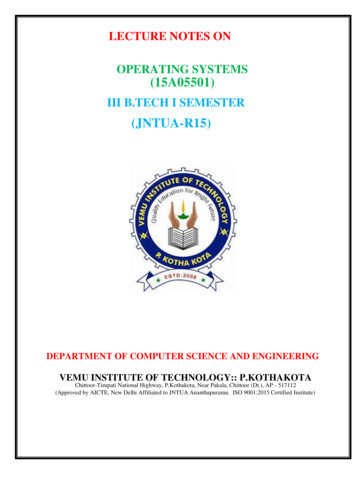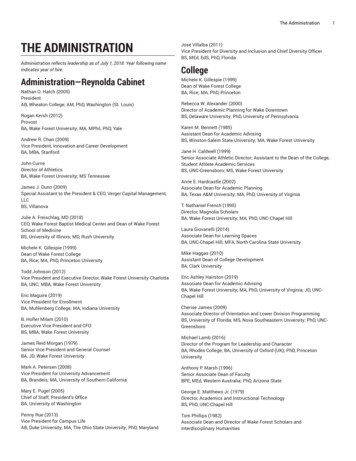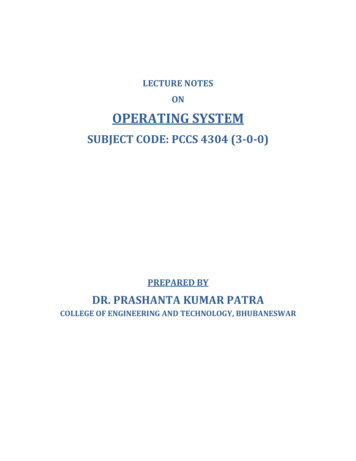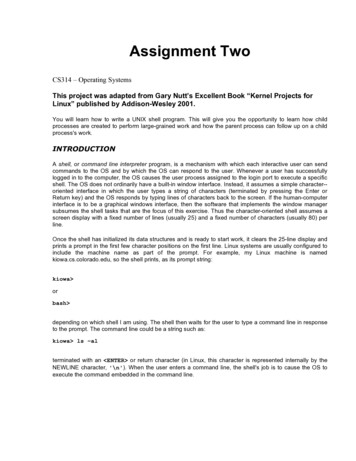
Transcription
Assignment TwoCS314 – Operating SystemsThis project was adapted from Gary Nutt’s Excellent Book “Kernel Projects forLinux” published by Addison-Wesley 2001.You will learn how to write a UNIX shell program. This will give you the opportunity to learn how childprocesses are created to perform large-grained work and how the parent process can follow up on a childprocess's work.INTRODUCTIONA shell, or command line interpreter program, is a mechanism with which each interactive user can sendcommands to the OS and by which the OS can respond to the user. Whenever a user has successfullylogged in to the computer, the OS causes the user process assigned to the login port to execute a specificshell. The OS does not ordinarily have a built-in window interface. Instead, it assumes a simple character-oriented interface in which the user types a string of characters (terminated by pressing the Enter orReturn key) and the OS responds by typing lines of characters back to the screen. If the human-computerinterface is to be a graphical windows interface, then the software that implements the window managersubsumes the shell tasks that are the focus of this exercise. Thus the character-oriented shell assumes ascreen display with a fixed number of lines (usually 25) and a fixed number of characters (usually 80) perline.Once the shell has initialized its data structures and is ready to start work, it clears the 25-line display andprints a prompt in the first few character positions on the first line. Linux systems are usually configured toinclude the machine name as part of the prompt. For example, my Linux machine is namedkiowa.cs.colorado.edu, so the shell prints, as its prompt string:kiowa orbash depending on which shell I am using. The shell then waits for the user to type a command line in responseto the prompt. The command line could be a string such as:kiowa ls –alterminated with an ENTER or return character (in Linux, this character is represented internally by theNEWLINE character, '\n'). When the user enters a command line, the shell's job is to cause the OS toexecute the command embedded in the command line.
Every shell has its own language syntax and semantics. In the standard Linux shell, bash, a command linehas the form:command [arg1] [arg2] . [argN]in which the first word is the command to be executed and the remaining words are arguments expectedby that command. The number of arguments depends on which command is being executed. For example,the directory listing command may have no arguments-simply by the user's typing “ls” or it may havearguments prefaced by the negative “-“ character, as in “ls –al”, where “a” and “l” are arguments. Thecommand determines the syntax for the arguments, such as which of the arguments may be grouped (asfor the “a” and “l” in the “ls” command), which arguments must be preceded by a "-" character, andwhether the position of the argument is important.Other commands use a different argument-passing syntax. For example, a g compiler command mightlook like:kiowa g -g -o deviation -S main.cpp inout.cpp –lmathin which the arguments g, o deviation, S, main.cpp, inout.cpp, and lmath are all passed tothe C compiler, g .The shell relies on an important convention to accomplish its task: The command for the command line isusually the name of a file that contains an executable program, for example, “ls” and “g ” (files stored in/bin on most UNIX-style machines). In a few cases, the command is not a filename but rather acommand that is implemented within the shell. For example, “cd” (change directory) is usuallyimplemented within the shell itself rather than in a file in /bin. Because the vast majority of the commandsare implemented in files, you can think of the command as actually being a filename in some directory onthe machine. This means that the shell's job is to:1 - find the file2 - prepare the list of parameters for the command,3 - cause the command to be executed using the parameters.Many shell programs are used with UNIX variants, including the original Bourne shell (sh), the C shell(csh) with its additional features over sh, the Korn shell, and the standard Linux shell (bash). All havefollowed a similar set of rules for command line syntax, though each has a superset of features.Basic UNIX-Style Shell OperationThe Bourne shell is described in Ritchie and Thompson's original UNIX paper [Ritchie and Thompson,1974]. As described in the previous subsection, the shell should accept a command line from the user,parse the command line, and then invoke the OS to run the specified command with the specified arguments. This command line is a request to execute the program in any file that contains a program,including programs that the user wrote. Thus a programmer can write an ordinary C program, compile it,and have the shell execute it just like it was a UNIX command.For example, suppose that you write a C program in a file named main.cpp and then compile andexecute it with shell commands such as:kiowa g -c –I. –o main.o main.cppkiowa g -o main.o mainkiowa ./main
For the first command line, the shell will find the g command (the C compiler) in the /bin directory andthen, when the g command is executed, pass it the string main.cpp. The C compiler will translatethe C program that is stored in main.cpp and write the resulting object file named main.o in the currentdirectory. The next command links the object file into an executable. The third command is simply thename of the file to be executed, main, without any parameters. The shell finds the main file in the currentdirectory and then executes it.Consider the following steps that a shell must take to accomplish its job.1. Print a prompt.A default prompt string is available, sometimes hardcoded into the shell, for example the singlecharacter string %, #, or . When the shell is started, it can look up the name of the machine onwhich it is running and prepend this string to the standard prompt character, for example a promptstring such as kiowa . The shell also can be designed to print the current directory as part of theprompt, meaning that each time that the user types cd to change to a different directory, the promptstring is redefined. Once the prompt string is determined, the shell prints it to stdout whenever it isready to accept a command line.2. Get the command line.To get a command line, the shell performs a blocking keyboard input operation so that the process thatexecutes the shell will be asleep until the user types a command line in response to the prompt. Oncethe user types the command line (and terminates it with a NEWLINE ('\n') character), the commandline string is returned to the shell.3. Parse the command.The syntax for the command line is trivial. The parser begins at the left side of the command line andscans until it sees a whitespace character (such as space, tab, or NEWLINE). The first word is thecommand name, and subsequent words are the parameters.4. Find the file.The shell provides a set of environment variables for each user. These variables are first defined in theuser's Iogin file (for the bash shell this is /home/ username /.bashrc) but they can be modified atany time by using the set command. The PATH environment variable (whose value can be viewed bytyping “echo PATH” at the bash shell) is an ordered list of absolute pathnames specifying where theshell should search for command files. If the Iogin file has a line such as:set path (.:/bin:/usr/bin)then the shell will first look in the current directory (since the first full pathname is ":."), then in /bin,and finally in /usr/bin. If no file with the same name as the command can be found in any of thespecified directories, then the shell notifies the user that it is unable to find the command.5. Prepare the parameters. The shell simply passes the parameters to the command as the argvarray of pointers to strings.
6. Execute the command.The shell must execute the executable program in the specified file. UNIX shells have alwaysbeen designed to protect the original process from crashing when it executes a program.That is, since a command can be any executable file, then the process that is executing theshell must protect itself in case the executable file contains a fatal error. Somehow, the shellwants to launch the executable so that even if the executable contains a fatal error (whichdestroys the process executing it), then the shell will remain unharmed.The Bourne shell uses multiple processes to accomplish this by using the UNIX-style system callsfork(), execvp(), and wait().fork()The fork() system call creates a new process that is a copy of the calling process, except that ithas its own copy of the memory, its own process ID (with the correct relationships to otherprocesses), and its own pointers to shared kernel entities such as file descriptors. After fork() hasbeen called, two processes will execute the next statement after the fork() in their own addressspaces: the parent and the child. If the call succeeds, then in the parent process fork() returns theprocess ID of the newly created child process and in the child process, fork() returns a zero value.execvp()The execvp() system call changes the program that a process is currently executing. It has theform:execvp(char* path, char* argv[]);The path argument is the pathname of a file that contains the new program to be executed. Theargv[] array is a list of parameter strings. When a process encounters the execvp() systemcall, the next instruction it executes will be the one at the entry point of the new executable file.Thus the kernel performs a considerable amount of work in this system call. It must:-find the new executable file,-load the file into the address space currently being used by the calling process (overwriting anddiscarding the previous program),-set the argv array and environment variables for the new program execution, and start the processexecuting at the new program's entry point.Various versions of execvp() are available at the system call interface, differing in the way thatparameters are specified (for example, some use a full pathname for the executable file and others donot).wait()The wait() system call is used by a process to block itself until the kernel signals the process to executeagain, for example because one of its child processes has terminated. When the wait() call returns as aresult of a child process's terminating, the status of the terminated child is returned as a parameter to thecalling process.
When these three system calls are used, here is the code skeleton that a shell might use to execute acommand:// Childif (fork() 0){execvp(fullpathname, argv);}// Parentelse{int status 0;wait(&status);cout "Child exited with status of " status endl;}Putting a Process in the BackgroundIn the normal paradigm for executing a command, the parent process creates a child process, starts itexecuting the command, and then waits until the child process terminates. If the "and" ("&") operator isused to terminate the command line, then the shell is expected to create the child process and start it executing on the designated command but not have the parent wait for the child to terminate. That is, theparent and the child will execute concurrently. While the child executes the command, the parent printsanother prompt to stdout and waits for the user to enter another command line. If the user starts severalcommands, each terminated by an "&", and each takes a relatively long time to execute, then manyprocesses can be running at the same time.When a child process is created and started executing on its own program, both the child and the parentexpect their stdin stream to come from the user via the keyboard and for their stdout stream to bewritten to the character terminal display. Notice that if multiple child processes are running concurrentlyand all expect the keyboard to define their stdin stream, then the user will not know which child processwill receive data on its stdin if data is typed to the keyboard. Similarly, if any of the concurrent processeswrite characters to stdout, those characters will be written to the terminal display wherever the cursorhappens to be positioned. The kernel makes no provision for giving each child process its own keyboard orterminal (unlike a windows system, which controls the multiplexing and demultiplexing through explicit useractions).I/O RedirectionA process, when created, has three default file identifiers: stdin, stdout, and stderr. These three fileidentifiers correspond to the C objects cin, cout, and cerr. If the process reads from stdin (usingcin) then the data that it receives will be directed from the keyboard to the stdin file descriptor. Similarly,data received from stdout (using cout) and stderr (using cerr) are mapped to the terminal display.The user can redefine stdin or stdout whenever a command is entered. If the user provides a filenameargument to the command and precedes the filename with a “less than” character " ” then the shell willsubstitute the designated file for stdin; this is called redirecting the input from the designated file.
The user can redirect the output (for the execution of a single command) by preceding a filename with theright angular brace character, " " character. For example, a command such askiowa we main.cpp program.statswill create a child process to execute the “we” command. Before it launches the command, however, it willredirect stdin so that it reads the input stream from the file main.cpp and redirect stdout so that itwrites the output stream to the file program.stats.The shell can redirect I/O by manipulating the child process's file descriptors. A newly created childprocess inherits the open file descriptors of its parent, specifically the same keyboard for stdin and theterminal display for stdout and stderr. (This expands on why concurrent processes read and write thesame keyboard and display.) The shell can change the child's file descriptors so that it reads and writes tofiles rather than to the keyboard and display.Each process has its own file descriptor table in the kernel. When the process is created, the first entry inthis table, by convention, refers to the keyboard (stdin) and the second two refer to the terminal display.Next, the C runtime environment and the kernel manage stdin, stdout, and stderr so that:C Object NamecincoutcerrAlternative LinuxNamestdinstdoutstderrFileDescriptorTable Index012Device ReferredToKeyboardTerminal DisplayTerminal DisplayIf you want to perform I/O redirection, you need to connect stdin to a file which can be read for inputinstead of the keyboard, or stdout to a file which can accept output instead of the terminal display.Let’s consider stdin specifically. The key to getting I/O redirection to work for stdin is to replace thecontents of the file descriptor entry for stdin, currently the keyboard, with the file descriptor entry for thefile you want to use for input.To accomplish this, you need to access the file descriptors for stdin and the file you want to read from.You know how to get the file descriptor for stdin, that’s just the number “0”. But how do you get the filedescriptor for the file you want to use for input? Unfortunately, you can’t get the file descriptor directly froma C ifstream object. Instead you have to issue the following Linux system call:int newstdin open(“main.cpp”,O RDONLY);The second argument to the open() call is an “open this file for reading only” flag. Now newstdin has a filedescriptor for the file “main.cpp”.Next you have to replace the contents of the stdin file descriptor with the “main.cpp” file descriptor. Usethe following sequence of Linux system calls:close(0);dup(newstdin);close(newstdin);The close(0) call wipes out the contents of file descriptor table entry 0, which is the table entry for stdin.The dup(newstdin) call copies the contents of the newstdin file descriptor table entry to the first empty tableentry in the file descriptor table. In this case, that will be entry 0. Now stdin is will use the file “main.cpp”instead of the keyboard for input. There are now two file descriptors which are linked to “main.cpp”. Thefinal close(newstdin) cleans things up so that only the stdin file descriptor is linked to main.cpp.
A similar set of calls is used if you want to redirect stdout to an output file:int newstdout open(“program.stats”,O WRONLY O CREAT,S IRWXU S IRWXG S ke sure that when you use this open call you include ALL of the flags I’ve listed here. Otherwise theredirection won’t work.Shell PipesThe pipe is a common IPC mechanism in Linux and other versions of UNIX. By default, a pipe employsasynchronous send and blocking receive operations. Optionally, the blocking receive operation may bechanged to be a nonblocking receive. Pipes are FIFO (first-in/first out) buffers designed with an API thatresembles as closely as possible a low level file I/O interface. A pipe may contain a system-definedmaximum number of bytes at any given time, usually 4KB. As indicated in Figure 2.2, a process can senddata by writing it into one end of the pipe and another can receive the data by reading the other end of thepipe.Information Flow Through a PipeA pipe is represented in the kernel by a file descriptor, just like a file. A process that wants to create a pipecalls the kernel with a call of the following form:int thePipe[2];pipe(thePipe);The kernel creates the pipe as a kernel FIFO data structure with two file identifiers. In this example code,thePipe[0] is a file pointer (an index into the process's open file table) to the read end of the pipe andthePipe[1] is file pointer to the write end of the pipe.For two or more processes to use pipes for IPC (interprocess communication), a common ancestor of theprocesses must create the pipe prior to creating the processes. Because the fork() command creates achild that contains a copy of the open file table (that is, the child has access to all of the files that theparent has already opened), the child inherits the pipes that the parent created. To use a pipe, it needsonly to read and write the proper file descriptors.For example, suppose that a parent creates a pipe. It then can create a child and communicate with it byusing a code fragment such as the following:
int pid;int thePipe[2];pipe(thePipe);pid fork();// Parentif(pid 0){char message "Hello";char messageLen 6;write(thePipe[1], message, messageLen);cout "Parent sent: " message endl;}// Childelse if (pid 0){char message[6];int messageLen 6;read(thePipe[0], message, messageLen);cout "Child received: " message endl;}Pipes enable processes to copy information from one address space to another by using the UNIX filemodel. The pipe read and write ends can be used in most system calls in the same way as a filedescriptor. Further, the information written to and read from the pipe is a byte stream. UNIX pipes do notexplicitly support messages, though two processes can establish their own protocol to provide structuredmessages. Also, library routines are available that can be used with a pipe to communicate via messages.A process that does not intend to use a pipe end should close so that end-of-file (EOF) conditions can bedetected.A named pipe can be used to allow unrelated processes to communicate with each other. Typically inpipes, the children inherit the pipe ends as open file descriptors. In named pipes, a process obtains a pipeend by using a string that is analogous to a filename but that is associated with a pipe. This allows any setof processes to exchange information by using a public pipe whose end names are filenames. When aprocess uses a named pipe, the pipe is a system-wide resource, potentially accessible by any process.Just as files must be managed so that they are not inadvertently shared among many processes at onetime, named pipes must be managed, by using low level file system commands.
Problem AWrite a C program that will act as a shell command line interpreter for the Linux kernel. Your shellprogram should use the same style as the bash shell for running programs. In particular, when the usertypes a line such as: command [parameter1] . [parameterN]your shell should parse the command line to build argv. It should search the directory system (in the orderspecified by the PATH environment variable) for a file with the same name as the first identifier (which maybe a relative filename or a full pathname). If the file is found, then it should be executed with the optionalparameter list, as is done with bash. If the file is not found, then an error should be printed.Use the execvp() system call to execute the file that contains the command. You will also need tobecome familiar with the Linux fork() and wait() functions.When the command has completed executing, your shell should prompt the user for another command.Here’s an example of the shell running a simple hello world program followed by the “ls” command:BobShell ./mainHello World!BobShell lsmain.cpp main.o main makefileBobShell Attacking Problem AThe exercise introduction generally describes how a shell behaves. It also implicitly provides a plan ofattack, summarized here. This plan describes several debugging versions that you can use for Part A, thenapply to the other parts as required.1. Organize the shell to initialize variables and then to perform an endless loop until the shell detects anEOF condition. When you are reading from stdin, an EOF condition can be:-CTRL-D character typedKeyword “exit” typedDevelop a very simple version that prints the prompt character and then waits for the user to type acommand. After it reads the command, it should print the command to stdout.2. Refine your simple shell so that it parses the command typed by the user. The parser should do thefollowing:-Convert each distinct string in the command into a C-StringStore the number of strings in the command in the integer variable argcStore the C-Strings in an array of character pointers declared like this:char* argv[100];
-Set the first location in the array after your C-Strings to NULL. You are going to pass the argvarray to the execvp() system call. This system call does NOT take argc as an argument, but thecall still needs to detect the end of the argv array. To detect the end of the argv array, execvplooks for the first array entry that has the value of NULL.3. In the next debug version, use argv[0] to find the executable file. In this version, simply print thefilename.-Construct a simple version that can find only command files that are in the current directory.Enhance your program so that it can find command files that are specified with an absolutepathname.Enable your program to search directories according to the string that is stored in the shell PATHenvironment variable. You can access all of the environment variables by adding the following twolines before main() in your program:#include unistd.h extern char *environ[];The last item in the array is a NULL C-String.3. Create a child process to execute the command.#include iostream using namespace std;//introduces namespace stdint main( void ){string theLine;intargc;char* argv[100];// Initialization stuffwhile (true){cout "BobShell ";getline(cin,theLine);cout "Command was: " theLine endl;if ((theLine "exit") argv[1]argv[2].argv[N]argv[N 1]the command name, and construct the parameter list- command name- first parameter- second parameter- Nth parameter- NULL to indicate end of parameter list// Find the full path name for the file
// Launch the executable file with the specified parameters using// the execvp command and the argv array.}Determining the Command Name and the Parameter ListA program might be run from your shell with the command:BobShell ./main foo 100Before calling execvp() you need to set up the argv array so that, argv[0] will point to the C-String “main”,argv[1] will point to “foo”, argv[2] will point to the string “100”, and argv[3] will be set to NULL to indicate theend of elements in the argv array. Your program then can interpret the first parameter (argv[1]) as, say, afilename, and the second parameter (argv[2]) as, say, an integer record count.The shell would simply treat the first word on the command line as a filename and the remaining words asstrings.Finding the Full PathnameThe user might have provided a full pathname as the command name word or only a relative pathnamethat is to be bound according to the value of the PATH environment variable. A name that begins with a "/""./" or "./" is an absolute pathname that can be used to launch the execution. Otherwise, your programmust search each directory in the list specified by the PATH environment variable to find the relativepathname.You can figure out if the file exists in a particular directory by trying to open the file. If the open fails, thenthe file does not exist.Launching the CommandThe final step in executing the command is to fork a child process to execute the specified command andthen to cause the child to execute that command. The following code skeleton will accomplish this.// Childif (fork() 0){execvp( fullpathnameofcommand , argv);}// Parentelse{int status 0;wait(&status);cout "Child exited with status of " status endl;}
Problem BAdd functionality to the shell from Problem A so that a user can use the "&" operator as a commandterminator. A command terminated with "&" should be executed concurrently with the shell (rather than theshell's waiting for the child to terminate before it prompts the user for another command).Problem CModify your shell program so that the user can redirect the stdin or stdout file descriptors by using the " "and " " characters as filename pre-fixes. For example:BobShell ./main out.txtBobShell cat out.txtHello World!BobShell will place the output of the “Hello World” program into the file “out.txt” rather than sending it to thescreen (which is stdout).Also, allow your user to use the pipe operator, "I", to execute two processes concurrently, with stdout fromthe first process being redirected as the stdin for the second process. For example:BobShell cat out.txtHello World!BobShell cat out.txt wc –l1BobShell The cat command sends the contents of the “out.txt” file to stdout. The “wc –l” command counts thenumber of characters, words, and lines typed into stdin. The two commands can be strung togetherusing the pipe operator “ ” so that the output of cat (sent to stdout) is connected to the input of wc(received from stdin).You can design your program so that you only have to handle redirection OR pipes in one command line,but not both.Attacking Problem CDon’t worry about mixing the “&”, redirection operators (“ ” and “ ”), and pipe operator “ ” in the samecommand.Concentrate on getting the redirection operators to work first. The key to getting these to work is tounderstand the I/O Redirection discussion in this document.Watch out for file permission problems with the redirection operators. I needed to bone up on the manpages for file() to get these flags correct. The default permissions for the file open for write meantsubsequent redirects to the same file didn't work of because permission problems.int newstdin open(inputFileName.c str(),O RDONLY);
int newstdout open(outputFileName.c str(),O WRONLY O CREAT,S IRWXU S IRWXG S IRWXO);To get command line pipes to work, re-read the Shell Pipes section carefully. Since a pipe is just like afile. there’s no reason why you couldn’t use I/O Redirection and pipes together!1 - Have the parent create a pipe.2 - Spawn a child.3 - Have the parent redirect stdout to the write portion of the pipe.4 - Have the parent execute the first command with excecvp().5 - Have the child redirect stdin to the read portion of the pipe.6 - Have the child execute the second command with execvp().7 - The output from the parent command should flow to the child command via the pipe and i/o redirectionyou performed on the pipe.Watch out for (EOF) problems with pipes. I couldn't get the child process to terminate on an eof conditionbecause the parent didn't close the read portion of the pipe. Make sure that for parent and child that youcall the system call close() for any portion of a pipe you aren’t using.General HintsYou should learn to use man pages to get info about important system calls. Sometimes the man page Iwanted didn't come up when I typed man keyword . For example:man waitgave me lots of information about the bash shell, not the system call wait. But I couldfind out about wait by typing:man 2 waitI figured this out by looking at the documentation. If you see something like:See also wait(2)It means use the syntax above.You should figure out how to get the error from a system call. If a system call fails, you can find out WHY itfailed in and English friendly way by calling strerror() with the global variable errno. Add this to your code:#include errno.h #include string.h extern int errno;. . .make a system call that failscout strerror(errno) endl;
DELIVERABLES:-All the files necessary to compile, link, and run your program solutions. The finalprogram that you produce should allow me to test the solutions to A, B, and C.Use a makefile to build your program so I can do the same thing when I build yourprogram.An ELECTRONIC document describing how to run the program you created. Callthis document README.TXT.These files should be placed in a directory called “ username assignment2”.Use the tar command to place all the files in a single file called“ username assignment2.tar” (e.g. tar –cvf bduganassignment2.tar bduganassignment1)-Upload your solution to elearn.
For the first command line, the shell will find the g command (the C compiler) in the /bin directory and then, when the g command is executed, pass it the string main.cpp.The C compiler will translate the C program that is stored in main.cpp and write the resulting object file named main.o in the current directory.

